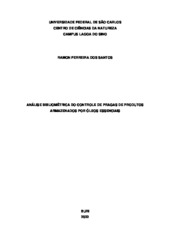| dc.contributor.author | Santos, Ramon Ferreira dos | |
| dc.date.accessioned | 2022-04-07T12:45:42Z | |
| dc.date.available | 2022-04-07T12:45:42Z | |
| dc.date.issued | 2022-03-24 | |
| dc.identifier.citation | SANTOS, Ramon Ferreira dos. Análise bibliométrica do controle de pragas de produtos armazenados por óleos essenciais. 2022. Trabalho de Conclusão de Curso (Graduação em Engenharia Agronômica) – Universidade Federal de São Carlos, Lagoa do Sino, 2022. Disponível em: https://repositorio.ufscar.br/handle/ufscar/15818. | * |
| dc.identifier.uri | https://repositorio.ufscar.br/handle/ufscar/15818 | |
| dc.description.abstract | Brazil is one of the biggest producers of grains in the world, but its maximum production potential has been threatened by the presence of stored grain pests that reduce the quality and quantity of grains. Given the inappropriate use of synthetic insecticides, selection pressure makes many of these pests increasingly resistant to control. On the other hand, the growing concern about the health of the population and the environment demands the development of less toxic and persistent products. Thus, essential oils, in their phytocomplexity, have potential for the management of unwanted organisms because they consist of several bioactive compounds, such as terpenes. The aim of this study was a bibliometric analysis of the evolution of the use of essential oils against the main pests of stored products in the world, through a systematic analysis of the bibliography indexed in the Web of Science and Scopus databases, seeking to understand the evolution of production scientific research in the scope of the use of essential oils in the control of pests of stored products, the identification of the main pests according to the analyzed bibliography and also the identification of plant species with potential for use in the control of these insects. Based on this analysis, it was found that the two most frequent species were the beetle Tribolium castaneum (Herbst) (Coleoptera: Tenebrionidae) and the corn weevil Sitophilus zeamais Motschulsky (Coleoptera: Curculionidae). The data obtained also allowed us to observe the progress of research in the use of these oils in the control of these two pests in the last 20 years, as well as to verify the performance of the main molecules present in oils of species belonging to 39 botanical families in these insects. | eng |
| dc.language.iso | por | por |
| dc.publisher | Universidade Federal de São Carlos | por |
| dc.rights | Attribution-NonCommercial-NoDerivs 3.0 Brazil | * |
| dc.rights.uri | http://creativecommons.org/licenses/by-nc-nd/3.0/br/ | * |
| dc.subject | Coleoptera | por |
| dc.subject | Fumigação | por |
| dc.subject | Produtos Naturais | por |
| dc.subject | Terpenos | por |
| dc.subject | Fumigation | eng |
| dc.subject | Natural Products | eng |
| dc.subject | Terpenes | eng |
| dc.title | Análise bibliométrica do controle de pragas de produtos armazenados por óleos essenciais | por |
| dc.title.alternative | Bibliometric analysis of control of stored products pests by essencial oils | eng |
| dc.type | TCC | por |
| dc.contributor.advisor1 | Matos, Andreia Pereira | |
| dc.contributor.advisor1Lattes | http://lattes.cnpq.br/6155202940087696 | por |
| dc.contributor.advisor-co1 | Araújo, Tamíris Alves de | |
| dc.contributor.advisor-co1Lattes | http://lattes.cnpq.br/4224270419293652 | por |
| dc.description.resumo | O Brasil é um dos maiores produtores de grãos no mundo, porém seu potencial máximo de produção é ameaçado pela presença de pragas de produtos armazenados que comprometem quali e quantitativamente os grãos. Tendo em vista a utilização inadequada de inseticidas sintéticos, a pressão de seleção torna muitas dessas pragas cada vez mais resistentes ao controle. Por outro lado, a crescente preocupação com a saúde da população e com o meio ambiente demanda o desenvolvimento de produtos menos tóxicos e persistentes. Assim, os óleos essenciais, em sua fitocomplexidade, apresentam potencial para o manejo de organismos indesejados por se constituírem de diversos compostos bioativos, como os terpenos. O objetivo deste trabalho foi uma análise bibliométrica da evolução da utilização de óleos essenciais frente às principais pragas de produtos armazenados no mundo, por meio de uma análise sistemática da bibliografia indexada nas bases de dados Web of Science e Scopus, buscando compreender a evolução da produção científica no âmbito da utilização de óleos essenciais no controle de pragas de produtos armazenados, a identificação das principais pragas segundo a bibliografia analisada e também a identificação de espécies vegetais com potencial para utilização no controle desses insetos. Com base nessa análise, constatou-se que as duas espécies mais frequentes foram o besouro Tribolium castaneum (Herbst) (Coleoptera: Tenebrionidae) e o gorgulho-do-milho Sitophilus zeamais Motschulsky (Coleoptera: Curculionidae). Os dados obtidos permitiram ainda observar o avanço das pesquisas na utilização desses óleos no controle dessas duas pragas nos últimos 20 anos, bem como verificar a atuação das principais moléculas presentes em óleos de espécies pertencentes a 39 famílias botânicas nesses insetos. | por |
| dc.publisher.initials | UFSCar | por |
| dc.subject.cnpq | CIENCIAS EXATAS E DA TERRA::QUIMICA::QUIMICA ORGANICA::QUIMICA DOS PRODUTOS NATURAIS | por |
| dc.publisher.address | Câmpus Lagoa do Sino | por |
| dc.contributor.authorlattes | http://lattes.cnpq.br/4061375774751274 | por |
| dc.publisher.course | Engenharia Agronômica - EAg-LS | por |

